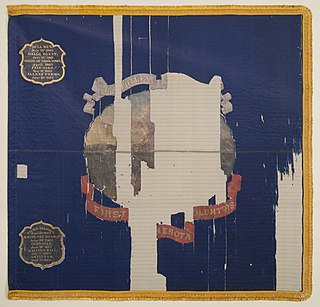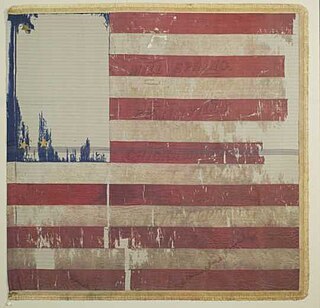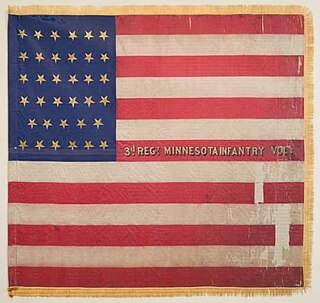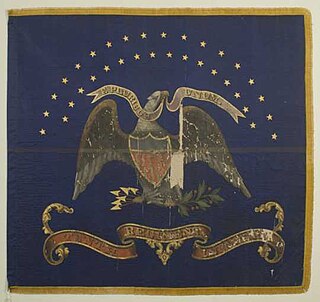
Fort Snelling is a former military fortification and National Historic Landmark in the U.S. state of Minnesota on the bluffs overlooking the confluence of the Minnesota and Mississippi Rivers. The military site was initially named Fort Saint Anthony, but it was renamed Fort Snelling once its construction was completed in 1825.

The 1st Minnesota Infantry Regiment was a Union infantry regiment active during the American Civil War. The 1st Minnesota participated in the battles of First Bull Run, Antietam and the Battle of Gettysburg. The regiment's most famous action occurred on the second day of the Battle of Gettysburg when Major General Winfield Scott Hancock ordered the 1st Minnesota to charge into a brigade of 1200 Confederate soldiers. This action blunted the Confederate attack and helped preserve the Union's precarious position on Cemetery Ridge.

The 2nd Minnesota Infantry Regiment was a Minnesota USV infantry regiment that served in the Union Army during the American Civil War. The regiment went on to campaign in the south and especially distinguish itself at the battles of Mill Springs, Chickamauga, and Missionary Ridge.

The 3rd Minnesota Infantry Regiment was a Minnesota USV infantry regiment that served in the Union army during the American Civil War. It fought in several campaigns in the Western Theater.

The 4th Minnesota Infantry Regiment was a Minnesota USV infantry regiment that served in the Union Army during the American Civil War. It served in several important campaigns in the Western Theater.

The 5th Minnesota Infantry Regiment was a Minnesota USV infantry regiment that served in the Union Army in the Western Theater of the American Civil War and Dakota War of 1862. The regiment distinguished itself serving in its home state and the south, particularly at the Battles of Fort Ridgely, Corinth and Nashville.
The 6th Minnesota Infantry Regiment was an infantry regiment that fought in the Union Army during the American Civil War. The 6th Minnesota Infantry spent much of the war in the Northwest fighting Dakota Indians rather than participating in the battles with the Confederacy. Led by William Crooks, the regiment saw action in the American Civil War mainly with the Dakota Tribe.

The 7th Minnesota Infantry Regiment was an infantry regiment in the Union Army that served in the Western Theater of the American Civil War.

The 8th Minnesota Infantry Regiment was a Minnesota USV infantry regiment that served in the Union Army during the American Indian Wars and the American Civil War.

The 9th Minnesota Infantry Regiment was a Minnesota USV infantry regiment that served in the Union Army in the Western Theater of the American Civil War.

The 10th Minnesota Infantry Regiment was a Minnesota USV infantry regiment that served in the Union Army during the American Civil War.
The 24th Wisconsin Infantry Regiment was a volunteer infantry regiment that served in the Union Army during the American Civil War.
The 25th Wisconsin Infantry Regiment was a volunteer infantry regiment that served in the Union Army during the American Civil War. During their service, they first participated in the Dakota War of 1862, then spent most of the rest of the war in the western theater.
Galvanized Yankees was a term from the American Civil War denoting former Confederate prisoners of war who swore allegiance to the United States and joined the Union Army. Approximately 5,600 former Confederate soldiers enlisted in the United States Volunteers, organized into six regiments of infantry between January 1864 and November 1866. Of those, more than 250 had begun their service as Union soldiers, were captured in battle, then enlisted in prison to join a regiment of the Confederate States Army. They surrendered to Union forces in December 1864 and were held by the United States as deserters, but were saved from prosecution by being enlisted in the 5th and 6th U.S. Volunteers. An additional 800 former Confederates served in volunteer regiments raised by the states, forming ten companies. Four of those companies saw combat in the Western Theater against the Confederate Army, two served on the western frontier, and one became an independent company of U.S. Volunteers, serving in Minnesota.
The 5th Iowa Cavalry Regiment was a cavalry unit from Iowa that served in the Union Army during the American Civil War.
The 21st Kentucky Infantry Regiment was an infantry regiment that served in the Union Army during the American Civil War.
Adam Marty was a Swiss-born member of the First Minnesota Volunteer Infantry Regiment during the American Civil War. After the war he became Commander of the Minnesota Department of the Grand Army of the Republic.
The 31st United States Colored Infantry was an infantry regiment raised in New York State during the American Civil War that recruited black soldiers.

William Crooks was a Colonel during the American Civil War, member of the Minnesota House of Representatives, U.S. Military Academy graduate, and a veteran railroader. He led the 6th Regiment Minnesota Volunteer Infantry from August 1862 to October 1864, mainly contending against the Sioux. Crooks built the first rail line in the State of Minnesota, the St. Paul & Pacific. His first locomotive he named for himself the William Crooks 4-4-0 and began its operation in 1861. His operation was taken over by James J. Hill. The William Crooks would become the first locomotive of Hill's Great Northern Railroad.
The 13th Minnesota Infantry Regiment was a United States volunteer infantry regiment active during the Spanish–American War and Philippine–American War. It's most well known for the role it played during the Battle of Manila as well as its efforts against Filipino resistance throughout 1899. It was one of four Minnesota regiments raised for the Spanish-American War and the only one to see combat.











